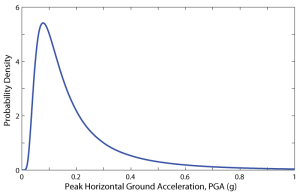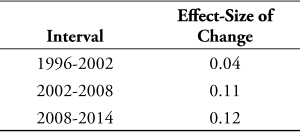The purpose of science is to explain and predict. Uncertainty in scientific predictions degrades their value. Uncertainty should not be hidden, but it should be reduced over time to show progress in science.
Predictions of future ground motions are needed for mitigation and insurance of seismic risk. The United States Geological Survey (USGS) is responsible for predicting future ground motions throughout the U.S. and territories. The USGS performs a probabilistic seismic hazard analysis (PSHA) by combining the uncertainties in time, location and size of earthquakes (geological models) with those in the ground motions for specific earthquakes (seismological models). The PSHA is performed out of necessity – rather than choice – because uncertainties in geological and seismological models are too high to be ignored at present time. Geological and seismological models are regularly updated and the PSHA repeated by the USGS.

Figure 1. Probability density function of 50-year maximum PGA for a ‘firm-rock’ site in Los Angeles, CA, based on the 2014 PSHA by the USGS.
For earthquake insurance, annual estimates of ground motions are needed because insurance policies are renewed every year. For seismic design, ground motion estimates are needed for the remaining life (or ownership) of the structure, say 50 years. During a 50-year time span, a site can be shaken by different earthquakes. The maximum ground chaking in 50 years is uncertain. Figure 1 shows the probability density function of 50-year maximum horizontal ground acceleration (PGA) for a ‘firm-rock’ site in Los Angeles, based on the 2014 PSHA by the USGS. According to Figure 1, any acceleration is possible in Los Angeles during the next 50 years. The expected (mean) value of 50-year maximum PGA is µ = 0.208 g (g = 9.81 m/s2) and its standard deviation is σ = 0.21g. The coefficient of variation (a common measure of uncertainty) is COV = 0.21/0.208 = 1.01.

Table 1. Mean µ, standard deviation σ, and coefficient of variation COV of 50-year maximum PGA for Los Angeles based on the PSHA by the USGS in 1996, 2002, 2008 and 2014.
Table 1 lists the mean µ, standard deviation σ, and coefficient of variation COV of 50-year maximum PGA based on the PSHA by the USGS in 1996, 2002, 2008 and 2014. Note that the uncertainty (COV) in ground motion prediction increased every time the PSHA was repeated. This suggests that the USGS was less certain of its predictions in 2014 than in 1996. There are three possible explanations for this surprising observation:
- As computers became faster and more powerful, it became possible for the USGS to consider more sources of uncertainty in the PSHA. This is somewhat ironic because computer resources should be used to decrease rather than increase uncertainty.
- The number of opinions regarding the geological and seismological models increased over the years due to greater number of researchers investigating the seismic hazard. The uncertainty increases when more and more opinions are incorporated into the PSHA.
- Seismic hazard analysis is in its early stages and geoscientists are still discovering more and more that they do not know.
Whatever the causes of rising uncertainty, this trend should be reversed to show progress in the science of ground motion prediction. Of course, uncertainty should not be hidden; it should only be reduced through a scientific process. Note in Table 1 that the mean value of maximum 50-year PGA has reduced since 1996. But is this reduction significant enough to warrant a change in design ground motions? The answer to that question is provided by the effect-size, defined as a change in the mean value as a fraction of the standard deviation. Table 2 lists the effect-size of change in ground motion predictions by the USGS between successive PSHA. The effect-size of 0.2 to 0.3 is considered small, ~0.5 is considered medium, and > 0.8 is considered large. Therefore, the effect-size of change in ground motion predictions by the USGS is too small to justify a change in design ground motions. In other words, the uncertainty in ground motion predictions is so high that a slight reduction in the ground motion estimates from 1996 to 2014 cannot be taken seriously.

Table 2. Effect-size of change in estimates of 50-year maximum PGA in Los Angeles between successive PSHA by the USGS.
In Los Angeles, the design acceleration for a building is 0.64 g according to ASCE 7-10, whereas the expected maximum acceleration in any given year is only 0.0129 g according to the USGS. The design acceleration is 50 times the expected acceleration in any given year, and still there is 1/5000 chance per year of collapse of a code-designed building and much higher chance of property damage. In Boston, where the uncertainty is higher than Los Angeles, the design acceleration is 75 times the expected maximum acceleration in any given year. High ratio between the design and expected maximum accelerations makes risk mitigation less attractive compared to insurance. But, insurance without mitigation is costly. Also, insurance cannot reverse the loss of life, loss of business, or the damage to the environment. Due to high uncertainty, voluntary mitigation gets pushed from one year to the next. There are significant social and economic reasons to reduce uncertainty in ground motion predictions, and yet there is no active discussion on reducing uncertainty.
Some suggestions for more meaningful application of PSHA are as follows:
- The PSHA should be considered as a tool for incorporating uncertainty; it should not be considered as an excuse for using models with high uncertainty. Models with high uncertainty increase the costs of mitigating and insuring the risk.
- The focus in seismic hazard analysis should shift from considering uncertainty to reducing uncertainty. In the seismic hazard community, there are more discussions on considering uncertainty, and practically no discussions on reducing uncertainty. This needs to change. The real progress in the science of ground motion prediction can only be made by reducing uncertainty.
- Uncertainty in geological and seismological models should be reduced by gradually replacing empirical models with physics-based models, and by limiting the number of opinions considered in the PSHA. Empirical models, by their very nature, are uncertain and there are several opinions regarding empirical models. For example, at present time, there are about 300 ground motion prediction (attenuation) models in the published literature.
- The design ground motions should not be revised unless a statistically significant change occurs in the predicted ground motions. The uncertainty in ground motion prediction is so high that a slight change in ground motion estimate does not justify a change in the design ground motions.
- Site-specific PSHA should not be used for the sole purpose of reducing design ground motions. Since there are many opinions regarding geological and seismological models, a combination of opinions can be easily found to obtain a lower estimate of the design ground motion. This practice should be stopped, because it provides a biased assessment of the risk.
- Same predictions of ground motions should be used for seismic design and insurance of all types of structures. There is no convincing argument for separate PSHA for buildings, bridges, dams and nuclear power plants. Design ground motions should be different for different types of structures, based on the consequence of damage; but the underlying assessment of the hazard should be the same.
- Seismic hazard models should not be made more complex unless they reduce uncertainty. It does not make sense for ground motion prediction models to become more complex and less certain at the same time. Complexity without certainty is self-serving.▪
References
[1] Cornell, C. A. (1971). “Probabilistic analysis of damage to structures under seismic loads.” Dynamic Waves in Civil Engineering, D. A. Howells, P. Haigh and C. Taylor (Editors), Wiley, New York, 473–488.
[2] Frankel, A. D., Mueller, C. S., Bernard, T., Perkins, D., Leyendecker, E. V., Dickman, N., Hanson. S., and Hopper, M. (1996). “National seismic-hazard maps: documentation June 1996.” Open-File Report 1996–532, U.S. Department of the Interior, U.S. Geological Survey.
[3] Frankel, A. D., Petersen, M. D., Mueller, C. S., Haller, K. M., Wheeler, R. L., Leyendecker, E. V., Wesson, R. L., Harmson, S. C., Cramer, C. H., Perkins, D. M. and Rukstales, K. S. (2002). “Documentation for the 2002 update of the national seismic hazard maps.” Open-File Report 2002–420, U.S. Department of the Interior, U.S. Geological Survey.
[4] Petersen, M. D., Frankel, A. D., Harmsen, S. C., Mueller, C. S., Haller, K. M., Wheeler, R. L., Wesson, R. L., Zeng, Y., Boyd, O. S., Perkins, D., M., Luco, N., Field, E. H., Wills, C. J., and Rukstales, K. S. (2008). “Documentation for the 2008 update of the United States national seismic hazard maps.” Open-File Report 2008–1128, U.S. Department of the Interior, U.S. Geological Survey
[5] Petersen, M. D., Moschetti, M. P., Powers, P. M., Mueller, C. S., Haller, K. M., Frankel, A. D., Zeng, Yuehua, Rezaeian, Sanaz, Harmsen, S. C., Boyd, O. S., Field, Ned, Chen, Rui, Rukstales, K. S., Luco, Nico, Wheeler, R. L., Williams, R. A., and Olsen, A. H. (2014). “Documentation for the 2014 update of the United States national seismic hazard maps.” U.S. Geological Survey. Open-File Report 2014–1091, 243 p.
[6] Cohen, J. (1988). Statistical Power Analysis for the Behavioral Sciences (second ed.), New Jersey, Lawrence Erlbaum Associates.
[7] ASCE (2010). Minimum design loads for buildings and other structures. ASCE/SEI 7-10, American Society of Civil Engineers, Reston, VA.
[8] Luco, N., Ellingwood, B. R., Hamburger, R. O., Hooper, J. D., Kimball, J. K., Kircher, C. A. (2007). “Risk-targeted versus current seismic design maps for the conterminous United States.” SEAOC 2007 Convention Proceedings.
[9] Malhotra, P. K. (2014). Cost of Uncertainty in Seismic Hazard. Seismological Research Letters, Submitted for Publication.
[10] Douglas, J. (2011). Ground-motion prediction equations 1964-2010, PEER Report 2011/102, Pacific Earthquake Engineering Research Center, College of Engineering, University of California, Berkeley.
